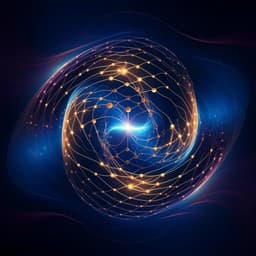
Physics
Imaging moiré deformation and dynamics in twisted bilayer graphene
T. A. D. Jong, T. Benschop, et al.
This study reveals exciting insights into the moiré pattern of twisted bilayer graphene, showcasing smaller spatial variations and the fascinating effects of thermal fluctuations, all conducted by authors from Leiden Institute of Physics and other prestigious institutions.
~3 min • Beginner • English
Introduction
Twisted bilayer graphene (TBG) exhibits a moiré superlattice that, near the magic twist angle (≈1.1°), produces flat electronic bands and correlated phases including insulating behavior and superconductivity. However, spatial inhomogeneity in twist angle and strain can strongly affect local electronic properties and, consequently, device-scale transport through percolative averaging. Prior studies have reported significant local variations, but limitations in sample geometry, capping layers, and imaging speed complicate comprehensive mapping. This work aims to quantify local spatial and temporal variations of the moiré pattern in device-relevant TBG using aberration-corrected low-energy electron microscopy (AC-LEEM), enabling large-area, fast, non-destructive imaging at elevated temperatures and offering spectroscopic capability. The study addresses whether local moiré disorder can be reduced by thermal annealing and whether high-temperature measurements risk untwisting of the layers.
Literature Review
Previous experimental probes (e.g., STM, TEM, scanning probes, SQUID and other local techniques) have revealed spatially varying twist angle and strain in TBG, with reports of substantial disorder and reconstructions toward Bernal stacking at small angles. Concerns have been raised that elevated temperatures may induce untwisting due to rotational energy differences, though direct observations of untwisting are scarce; relaxation effects were observed only above ~800 °C in prior work, and theory suggests large flakes are rotationally stable. Strain is known to tune electronic structure and may induce quantum phase transitions in magic-angle graphene. Earlier measurements often reported larger standard deviations in twist angle and strain within domains. Moiré patterns can also magnify underlying lattice deformations and topological defects such as edge dislocations, which are known from TEM studies in single-layer graphene to exhibit dynamics and coupling to lattice deformations. These defects may have unique local electronic signatures via symmetry breaking and Berry-phase effects.
Methodology
- Samples: TBG fabricated via tear-and-stack. A monolayer graphene flake was torn and rotated by ~1.0° before pickup, then transferred onto ~140 nm hBN on Si/SiO2. Part of the graphene contacted Si for electrical grounding. PC/PDMS stamp used; PC dissolved in chloroform for 3 h.
- AC-LEEM measurements: Conducted in an aberration-corrected SPECS P90-based ESCHER LEEM under UHV (≤1×10⁻⁹ mbar). Samples heated at ≤0.45 K/s to 450–500 °C (unless specified) to reduce contamination. Imaging performed across 0–100 eV landing energies. High-dynamic-range spectra acquired with drift and detector artifact corrections.
- Imaging strategy: Layer count determined from LEEM reflectivity spectra (interlayer resonances below ~5 eV and suppression near 8 eV). False-color composite images constructed using 4 eV (red), 8 eV (green), and 17 eV (blue) to map layer number and heterostructure regions. For moiré mapping, imaging at ~37 eV optimized stacking contrast. Large field-of-view obtained by stage scanning and custom stitching (overlapping 4.7 µm fields with 2 µm steps) using a deformation-minimizing algorithm; cross-energy registration corrected minor rotation/magnification differences.
- Time series: Dynamics recorded as back-to-back sequences of accumulated ~1 s exposures. Each frame underwent detector correction, drift correction, normalization by Gaussian-smoothed copy (σ=50 px) to remove illumination fluctuations, and temporal Gaussian filtering (σ ≈ 1 image ≈ 1 s) prior to analysis.
- Image analysis: Adaptive geometric phase analysis (GPA) with a grid of reference wave vectors to extract local displacement fields, twist angle θ(r), and heterostrain magnitude and direction ε(r). Phase gradients converted directly to the displacement gradient tensor to avoid global unwrapping issues. The method captures moiré magnification of atomic distortions (factor ≈1/6 and rotation ≈90°+θ/2).
- Spectral calculations: Ab initio Bloch-wave-based scattering (APW) used to compute LEEM reflectivity for different stackings. Full-potential LAPW Kohn-Sham potential within LDA; inelastic scattering via a spatially constant imaginary potential (~0.5 eV) within the slab and Gaussian broadening (1 eV) to mimic experimental losses.
- Auxiliary: AFM used to assess topography around defects; analysis code in Python (NumPy, SciPy, scikit-image, Dask; plotting with Matplotlib).
Key Findings
- Device-scale moiré imaging: AC-LEEM at 37 eV revealed spatially varying moiré periodicities and distortions across fold-separated domains. Observed twist angles ranged from <0.1° to 0.7° on the main sample; best resolution achieved on a separate sample with θ ≈ 1.3°.
- Reconstruction at small angles: For smaller twist angles, local reconstruction toward Bernal stacking within the moiré lattice was observed, consistent with prior reports.
- Quantitative disorder within domains: Adaptive GPA showed that within each domain, twist-angle standard deviations are only ~0.005°–0.015°, i.e., 3–10 times smaller than previously reported values. Heterostrain is on the order of a few tenths of a percent, with average atomic-lattice strain up to ~0.4% in some domains—large enough to potentially induce local quantum phase transitions per theory.
- Thermal stability of twist angle: No evidence of untwisting was found from 100 °C up to 600 °C across all samples studied, including those with larger domains.
- High-temperature dynamics: At 500 °C, stacking domain boundaries exhibit subtle temporal fluctuations. Boundary displacements of ~4 nm correspond, via moiré magnification, to collective atomic translations of <70 pm over seconds. Extracted thermal fluctuation amplitudes are ~±0.005° in θ and ~±0.02% in strain—smaller than static deformations but non-negligible.
- Edge dislocations: Individual edge dislocations in the moiré lattice were identified via GPA phase singularities and Burgers vector analysis. Defects appeared stable under prolonged low-energy electron irradiation and high temperature; only one moved several moiré cells before pinning. AFM indicates flattening (no out-of-plane buckling), likely due to vdW adhesion to hBN. The moiré landscape may stabilize defects through local stacking-fault energy minima.
- Practical implication: Heating appears to relax and homogenize the local moiré lattice, suggesting thermal annealing can reduce local disorder without inducing untwisting.
Discussion
The study addresses the central question of how spatial and temporal variations in the moiré structure of TBG influence local electronic properties and whether high-temperature processing can homogenize the lattice without compromising twist angle. Large-area, high-resolution AC-LEEM imaging combined with adaptive GPA reveals that intrinsic variations of twist angle and strain within fold-bounded domains are significantly smaller than previously reported, implying that earlier measurements may have been influenced by lower temperatures, different analysis PSFs, or sample preparation. The observed thermal fluctuations at 500 °C, involving collective but sub-angstrom atomic displacements, point to a mechanism for short-range twist angle disorder at low temperatures: frozen-in thermal fluctuations of the moiré lattice. Importantly, the persistent absence of untwisting up to 600 °C suggests that device-level annealing can be employed to reduce local moiré disorder without risking loss of twist angle, though distinguishing intrinsic rotational stability from defect pinning requires further isolated-domain studies. The discovery of stable edge dislocations in the moiré lattice, with potential for unique local electronic responses, underscores the role of topological defects in moiré systems and highlights the moiré pattern as a sensitive magnifier of atomic-scale deformations.
Conclusion
This work establishes AC-LEEM as a powerful, non-destructive tool for device-scale mapping of moiré structures in TBG and quantifying local twist angle and strain via adaptive GPA. Key contributions include: (i) demonstrating substantially smaller intra-domain twist-angle disorder (0.005°–0.015° s.d.) and heterostrain variability than previously reported, (ii) showing that TBG does not untwist up to 600 °C, (iii) revealing high-temperature moiré dynamics corresponding to sub-angstrom atomic displacements, and (iv) identifying stable edge dislocations in the moiré lattice. These findings indicate that controlled thermal annealing can reduce local moiré disorder and potentially improve device homogeneity and performance. Future directions include: temperature-dependent statistical analysis of domain-boundary dynamics to map the energy landscape; experiments on isolated, homogeneous domains to separate intrinsic rotational stability from pinning effects; and correlative studies (STS, nanoARPES, in situ potentiometry) to probe the electronic signatures of moiré dislocations and strained regions.
Limitations
- The adaptive GPA method introduces an analysis point-spread function broader than the instrument’s, damping high-spatial-frequency components and potentially reducing the measured variation and fluctuation amplitudes.
- Dynamic fluctuation values are further damped by temporal integration and filtering.
- Measurements were performed predominantly at elevated temperatures (450–500 °C); direct extrapolation to low-temperature behavior requires caution.
- The study cannot unambiguously distinguish between intrinsic rotational stability and pinning of the moiré lattice by defects; isolated homogeneous areas are needed to decouple these effects.
- Imaging through thick capping layers was not demonstrated; applicability may be limited to uncapped or very thinly capped samples.
- Electronic properties were inferred from structural variations; direct electronic measurements near defects or strained regions were not performed in this work.
Related Publications
Explore these studies to deepen your understanding of the subject.







